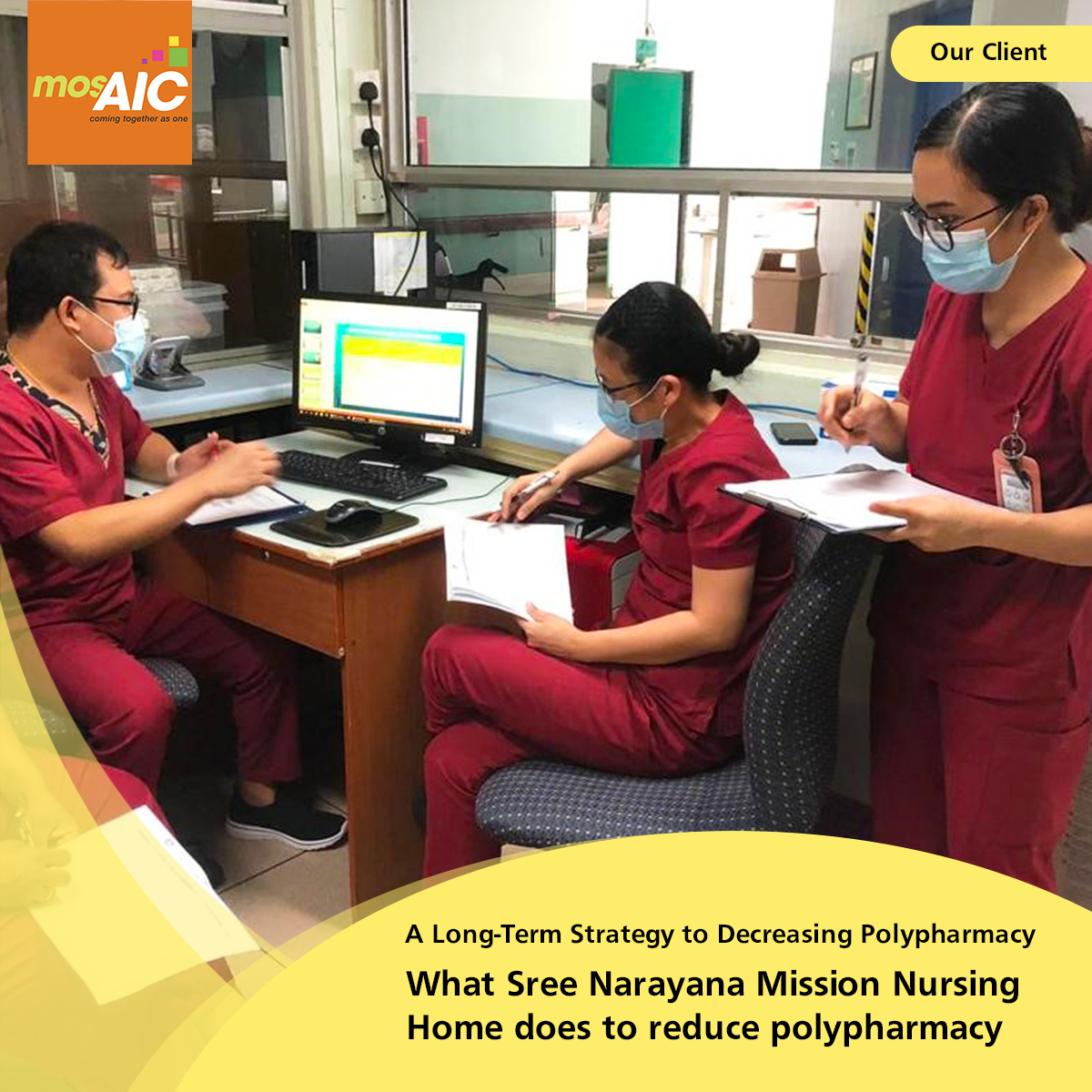What Sree Narayana Mission Nursing Home Does to Reduce Polypharmacy

In a bid to improve the quality of care and productivity in hospitals, nursing homes, communities or at home, our Community Care partners are constantly on a quest to improve the well-being and services for seniors in the community. With improvements in the quality of clinical care, more organisations are now able to better the lives of seniors in the long-term care sector. mosAIC explores how our partner is improving clinical care in their organisation.
As we age, the risk for developing chronic diseases becomes higher. As a result, seniors might need frequent use of various medications to manage these conditions, which is known as polypharmacy. The definition of polypharmacy ranges from the use of five or more medications to the use of a large number of potentially inappropriate medications or duplication of medication. Any additional medicine or a change in dosage could definitely increase the risk of side effects, drug interaction and medication incidents.
Polypharmacy has been a growing issue in Singapore. An analysis in 2015 by the Pharmaceutical Society of Singapore done in three nursing homes showed that more than half of the elderly patients were on more than five medications, and inappropriate medication use was seen in 70% of the residents. To improve medication safety and reduce polypharmacy in their residents, Sree Narayana Mission (SNM) Nursing Home decided to start an initiative and introduced the Polypharmacy Form.
How The Polypharmacy Project Started
The Polypharmacy Form was developed and implemented to reduce the use of multiple medications per resident. While the use of multiple medicines may be clinically appropriate for some patients, it was important to identify patients who may be at risk of adverse health outcomes as a result of inappropriate polypharmacy. The purpose of the form was to guide nursing staff in identifying and flagging out the risks to doctors or pharmacists, which then allowed for the deprescription of unsuitable medications. To further ensure the reduced risk in medication incidents, the nursing staff were also trained on medication safety, and medication-related side effects.
A project team rolled out the use of Polypharmacy Form in a pilot ward in October 2019. Within 10 months, the average number of medications reduced from 12.4 to 11.08 per resident. The team had successfully cut down the number of medications needed per resident by 10.6%.
The Benefits of Using a Polypharmacy Form
With the pilot project’s commencement in October 2019, the seniors at SNM Nursing Home have since benefited from this initiative. The improvements for the residents were as follows:
- Fewer tablets to swallow
- Lower risk of medication side effects with fewer medications
- Lower risk of drug interactions
- Lower risk of medication incidents
Simultaneously, a client-centred approach of care towards the seniors was also applied, allowing for clearer communication between the staff and residents. Equipped with an increased understanding of medication-related knowledge, the SNM Nursing Home staff involved in this initiative saw the following benefits:
- Increased awareness of medication safety
- Greater knowledge of common medication-related side effects
- Better teamwork with a shared goal
- Reduced risk of medication incidents
- Empowered to improve their clinical judgement and take appropriate actions
Implementing the Use of Form Throughout the Nursing Home
Following its success in the pilot programme, the form was then implemented in the other wards. As of December 2020, the team has successfully described a total of 257 medications across the Nursing Home. The acceptance rate of the recommendations raised by nursing staff guided by the Polypharmacy Form to doctors and pharmacists was 96%.
On top of efforts to promote medication safety, the team has also taken steps to reduce constipation and improve hypoglycaemia management among their residents. This includes the development and implementation of a Constipation Care Bundle and a Hypoglycaemia Protocol.
The Medication Safety Goal
By improving medication safety with reduced polypharmacy, SNM Nursing Home aims to provide elderly patients with the best possible treatment with reduced risks. The lower risk of medication side effects, drug interactions and medication incidents would allow for a viable care plan for residents.
This project is just one of many among the Medication Safety Collaborative organised by the Agency for Integrated Care, which involves multiple Nursing Home project teams working towards the same goal of Medication Safety.
About SNM Nursing Home
Established in 1948, Sree Narayana Mission (SNM) is a leading Social Service Agency that has touched the lives of thousands of individuals, regardless of race, language or religion. SMN provides services for the elderly through the SNM Nursing Home in Yishun, two Senior Care Centres and community outreach programmes. Check out their Facebook page for more information.
More from mosAIC:
Pneumonia Prevention in Seniors: How Econ Medicare Centre And Nursing Home - CCK is Integrating Treatment Interventions
Virtual Reality for Seniors: How Lions Home for the Elders is Transforming the Rehab Experience
How A Therapeutic Garden Helps In Dementia Therapy At All Saints Home
